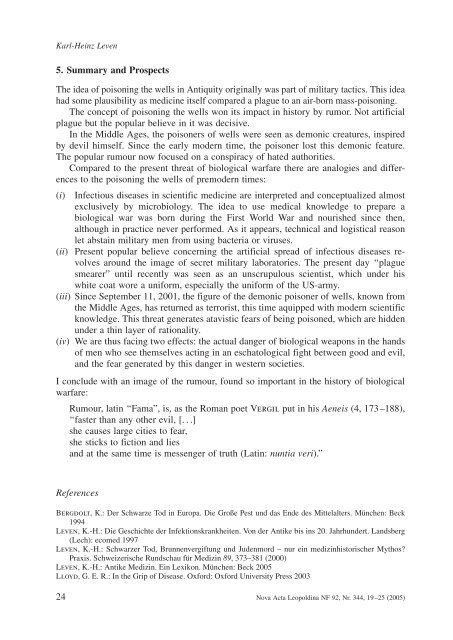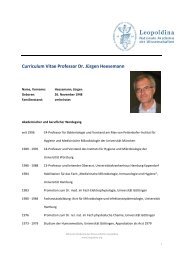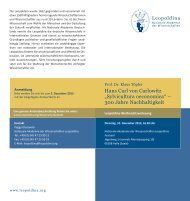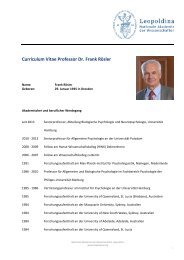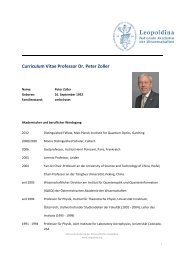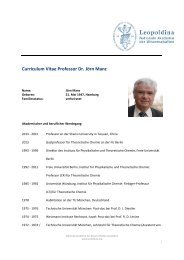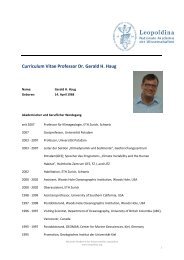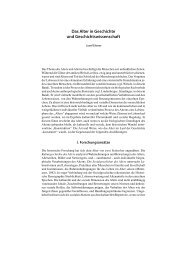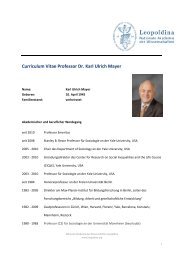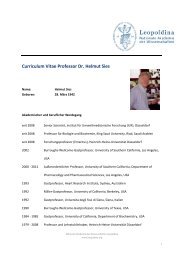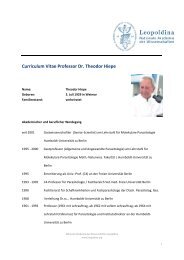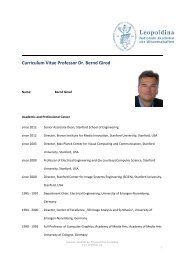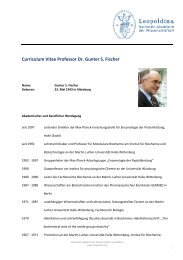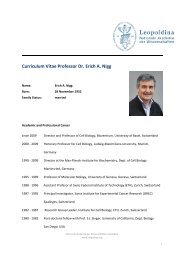Biological Warfare ± Perspectives from Premodern ... - Leopoldina
Biological Warfare ± Perspectives from Premodern ... - Leopoldina
Biological Warfare ± Perspectives from Premodern ... - Leopoldina
Create successful ePaper yourself
Turn your PDF publications into a flip-book with our unique Google optimized e-Paper software.
Karl-Heinz Leven<br />
5. Summary and Prospects<br />
The idea of poisoning the wells in Antiquity originally waspart of military tactics. This idea<br />
had some plausibility as medicine itself compared aplague toan air-born mass-poisoning.<br />
The concept of poisoning the wells won its impact inhistory by rumor. Not artificial<br />
plague but the popular believe in it was decisive.<br />
In the Middle Ages, the poisoners ofwells were seen as demonic creatures, inspired<br />
by devil himself. Since the early modern time, the poisoner lost this demonic feature.<br />
The popular rumour now focused on aconspiracy ofhated authorities.<br />
Compared to the present threat ofbiological warfare there are analogies and differences<br />
to the poisoning the wells of premodern times:<br />
( i ) Infectious diseases inscientific medicine are interpreted and conceptualized almost<br />
exclusively by microbiology. The idea to use medical knowledge to prepare a<br />
biological war was born during the First World War and nourished since then,<br />
although in practice never performed. Asitappears, technical and logistical reason<br />
let abstain military men <strong>from</strong> using bacteria or viruses.<br />
( ii) Present popular believe concerning the artificial spread ofinfectious diseases revolves<br />
around the image of secret military laboratories. The present day ``plague<br />
smearerº until recently was seen as an unscrupulous scientist, which under his<br />
white coat wore auniform, especially the uniform of the US-army.<br />
( iii) Since September 11, 2001, the figure of the demonic poisoner of wells, known <strong>from</strong><br />
the Middle Ages, has returned as terrorist, this time aquipped with modern scientific<br />
knowledge. This threat generates atavistic fears of being poisoned, which are hidden<br />
under athin layer ofrationality.<br />
( iv) Weare thus facing two effects: the actual danger of biological weapons in the hands<br />
of men who see themselves acting in an eschatological fight between good and evil,<br />
and the fear generated by this danger in western societies.<br />
Iconclude with an image of the rumour, found so important in the history of biological<br />
warfare:<br />
Rumour, latin ``Famaº, is, asthe Roman poet V ergil put in his Aeneis (4, 173 <strong>±</strong>188),<br />
``faster than any other evil, [...]<br />
she causes large cities to fear,<br />
she sticks to fiction and lies<br />
and at the same time is messenger of truth (Latin: nuntia veri ).º<br />
References<br />
B ergdolt , K.: Der Schwarze Tod in Europa. Die Groûe Pest und das Ende des Mittelalters. MuÈnchen: Beck<br />
1994<br />
L even, K.-H.: Die Geschichte der Infektionskrankheiten. Von der Antike bis ins 20. Jahrhundert. Landsberg<br />
(Lech): ecomed 1997<br />
L even, K.-H.: Schwarzer Tod, Brunnenvergiftung und Judenmord <strong>±</strong>nur ein medizinhistorischer Mythos?<br />
Praxis.Schweizerische RundschaufuÈ rMedizin 89,373<strong>±</strong>381 (2000)<br />
L even, K.-H.: Antike Medizin. Ein Lexikon.MuÈnchen:Beck 2005<br />
L loyd,G.E.R.: In the Grip of Disease.Oxford: Oxford University Press 2003<br />
24 Nova Acta <strong>Leopoldina</strong> NF 92, Nr. 344, 19 <strong>±</strong>25 (2005)


